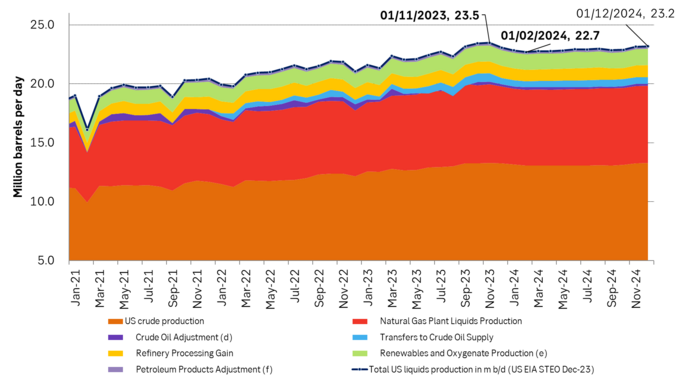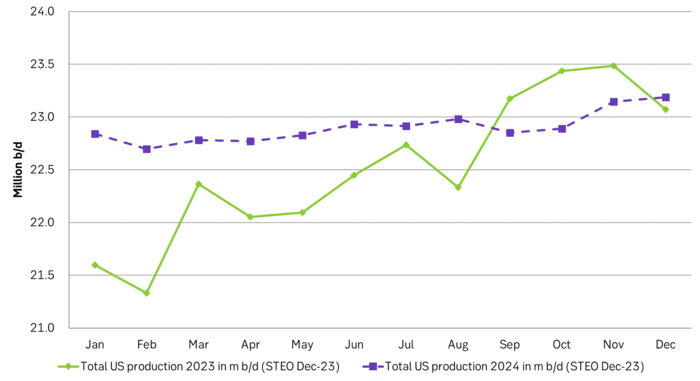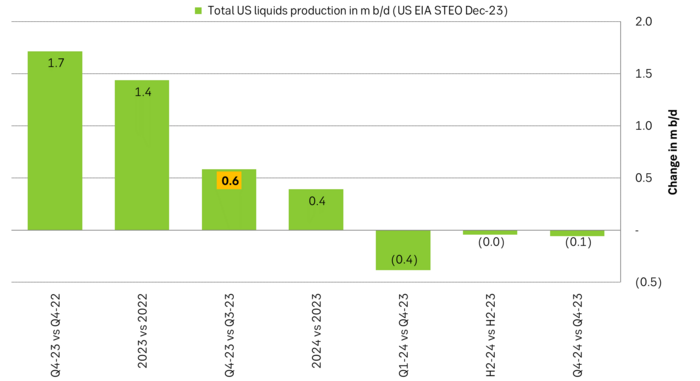Analys
2024 looks to be a very good year for OPEC+

2024 looks to be a very good year for OPEC+. IEA’s crystal ball projects a marginal 0.2 m b/d decline in the need for oil from OPEC to 28.2 m b/d. But that is easy for OPEC handle as it holds out waiting for the re-acceleration in global manufacturing some time in the future. What really catches our attention is the US EIA’s projection of US liquids falling 0.4 m b/d QoQ to Q1-24 and then going close to sideways the rest of 2024 with production down YoY in both H2-24 and Q4-24. This is the best Christmas present ever to OPEC(+) if it plays out like this. Icing on the cake for OPEC+ is that the US now has started to think like an oil exporter who doesn’t like the oil price to drop as it would hurt oil-jobs, production and oil exports. ”Mine at USD 79/b” says the US Office of Petroleum Reserves as it aims to rebuild its SPR.

IEA depicts a slightly lower Call-on-OPEC in 2024 but nothing OPEC(+) can’t handle. Yes, there are concerns for global oil demand both now and next year. In its monthly report today the IEA adjusted Q4-23 demand down by 0.6 m b/d and demand for 2024 down by 0.1 m b/d to 102.8 m b/d. It also adjusted its projection for non-OPEC supply 2024 up by 0.1 m b/d to 69 m b/d. The implication is that Call-on-OPEC falls to 28.2 m b/d in 2024 as non-OPEC supply is projected to grow slightly faster than global demand. Call-on-OPEC was 28.4 m b/d in 2021, 2022 and 2023. Equal for all three years. It is of course bad news for OPEC that the need for its oil declines by 0.2 m b/d in 2024 in IEA’s projection. But that is totally within the capacity of OPEC(+) to adapt to. If IEA’s scenario plays out, then there is no sweat at all for OPEC+. It will then be easy sailing for the group to control the oil market as it wish with just a small, marginal adjustment of supply.
US EIA depicts an OPEC dream scenario for 2024. What stands out the most in our view is the monthly STEO report from the US EIA on Tuesday this week. It projects that US production of hydrocarbon liquids will shift abruptly from booming supply growth in 2023 (+1.4 m b/d YoY) to instead a QoQ decline of 0.4 m b/d in Q1-24 and then basically flat-lining the rest of 2024. US production is set to be down YoY in both H2-24 and Q4-24 the EIA projects.
This is a dream scenario for OPEC+. It is really the best Christmas gift it could get from the US. The fundamental challenge for OPEC+ is booming non-OPEC+ supply. And US shale oil supply is the dominating element in that respect. OPEC+ has very little to worry about in 2024 if US liquids production plays out as the US EIA now projects.
What was special in Q4-23 was that US liquids production rose 0.6 m b/d QoQ while global oil demand contracted 0.6 m b/d QoQ at the same time with declining oil prices as a result.
The US SPR office joins in: ”Mine at USD 79/b” (”Mine at USD 79/b”). From Jan 2022 to Nov 2023 the US poured 242 million barrels of oil from its Strategic Petroleum Reserves (SPR) into the commercial market. This prevented oil prices from rallying out of control. But it has also drawn US SPR inventories down to only 50% capacity. The US wants to rebuild its SPR. A while back it said it would be a buyer if the WTI price fell down to USD 67-72/b. Recently however it stated that it would buy if the price is USD 79/b or lower. The volumes aren’t enormous but the are noticeable and they could be larger if Congress allocates more money to rebuild the SPR.
The US is starting to think like an oil exporter. It doesn’t want the oil price to drop. Rebuilding the US SPR is a win-win for the US. 1) It gets to rebuild its SPR for later strategic use and 2) It ensures that the oil price doesn’t drop hard to low levels which would lead to a sharp decline in US oil production, shedding of employees in the US oil sector and a sharp reduction in US oil exports. The US is starting to think like an oil exporter. Just like OPEC+ it doesn’t like the oil price to drop.
US liquids production with projection to 2024 in m b/d. Projected to flat-line in 2024

US liquids production with projection to 2024 in m b/d. A sharp decline into Q1-24

Total US liquids production grew very strongly in 2023. Especially in Q4-23 vs Q3-24. Projected to contract by 0.4 m b/d into Q1-24 almost reversing the gain in Q4-23

Source: Source: SEB graph, Data from US EIA STEO December report.
Analys
Sell the rally. Trump has become predictable in his unpredictability

Hesitant today. Brent jumped to an intraday high of $66.36/b yesterday after having touched an intraday low of $60.07/b on Monday as Indian and Chinese buyers cancelled some Russian oil purchases and instead redirected their purchases towards the Middle East due to the news US sanctions. Brent is falling back 0.4% this morning to $65.8/b.

It’s our strong view that the only sensible thing is to sell this rally. In all Trump’s unpredictability he has become increasingly predictable. Again and again he has rumbled about how he is going to be tough on Putin. Punish Putin if he won’t agree to peace in Ukraine. Recent rumbling was about the Tomahawk rockets which Trump threatened on 10 October and 12 October to sell/send to Ukraine. Then on 17 October he said that ”the U.S. didn’t want to give away weapons (Tomahawks) it needs”.
All of Trump’s threats towards Putin have been hot air. So far Trump’s threats have been all hot air and threats which later have evaporated after ”great talks with Putin”. After all these repetitions it is very hard to believe that this time will be any different. The new sanctions won’t take effect before 21. November. Trump has already said that: ”he was hoping that these new sanctions would be very short-lived in any case”. Come 21. November these new sanctions will either evaporate like all the other threats Trump has thrown at Putin before fading them. Or the sanctions will be postponed by another 4 weeks or 8 weeks with the appearance that Trump is even more angry with Putin. But so far Trump has done nothing that hurt Putin/Russia. We can’t imagine that this will be different. The only way forward in our view for a propre lasting peace in Ukraine is to turn Ukraine into defensive porcupine equipped with a stinging tail if need be.
China will likely stand up to Trump if new sanctions really materialize on 21 Nov. Just one country has really stood up to Trump in his tariff trade war this year: China. China has come of age and strength. I will no longer be bullied. Trump upped tariffs. China responded in kind. Trump cut China off from high-end computer chips. China put on the breaks on rare earth metals. China won’t be bullied any more and it has the power to stand up. Some Chinese state-owned companies like Sinopec have cancelled some of their Russian purchases. But China’s Foreign Ministry spokesperson Guo Jiakun has stated that China “oppose unilateral sanctions which lack a basis in international law and authorization of the UN Security Council”. Thus no one, not even the US shall unilaterally dictate China from whom they can buy oil or not. This is yet another opportunity for China to show its new strength and stand up to Trump in a show of force. Exactly how China choses to play this remains to be seen. But China won’t be bullied by over something as important as its oil purchases. So best guess here is that China will defy Trump on this. But probably China won’t need to make a bid deal over this. Firstly because these new sanctions will either evaporate as all the other threats or be postponed once we get to 21 November. Secondly because the sanctions are explicit towards US persons and companies but only ”may” be enforced versus non-US entities.
Sanctions is not a reduction in global supply of oil. Just some added layer of friction. Anyhow, the new sanctions won’t reduce the supply of Russian crude oil to the market. It will only increase the friction in the market with yet more need for the shadow fleet and ship to ship transfer of Russian oil to dodge the sanctions. If they materialize at all.
The jump in crude oil prices is probably due to redirections of crude purchases to the Mid-East and not because all speculators are now turned bullish. Has oil rallied because all speculators now suddenly have turned bullish? We don’t think so. Brent crude has probably jumped because some Indian and Chinese oil purchasers of have redirected their purchases from Russia towards the Mid-East just in case the sanctions really materializes on 21 November.
Analys
Brent crude set to dip its feet into the high $50ies/b this week

Parts of the Brent crude curve dipping into the high $50ies/b. Brent crude fell 2.3% over the week to Friday. It closed the week at $61.29/b, a slight gain on the day, but also traded to a low of $60.14/b that same day and just barely avoided trading into the $50ies/b. This morning it is risk-on in equities which seems to help industrial metals a little higher. But no such luck for oil. It is down 0.8% at $60.8/b. This week looks set for Brent crude to dip its feet in the $50ies/b. The Brent 3mth contract actually traded into the high $50ies/b on Friday.

The front-end backwardation has been on a weakening foot and is now about to fully disappear. The lowest point of the crude oil curve has also moved steadily lower and lower and its discount to the 5yr contract is now $6.8/b. A solid contango. The Brent 3mth contract did actually dip into the $50ies/b intraday on Friday when it traded to a low point of $59.93/b.
More weakness to come as lots of oil at sea comes to ports. Mid-East OPEC countries have boosted exports along with lower post summer consumption and higher production. The result is highly visibly in oil at sea which increased by 17 mb to 1,311 mb over the week to Sunday. Up 185 mb since mid-August. On its way to discharge at a port somewhere over the coming month or two.
Don’t forget that the oil market path ahead is all down to OPEC+. Remember that what is playing out in the oil market now is all by design by OPEC+. The group has decided that the unwind of the voluntary cuts is what it wants to do. In a combination of meeting demand from consumers as well as taking back market share. But we need to remember that how this plays out going forward is all at the mercy of what OPEC+ decides to do. It will halt the unwinding at some point. It will revert to cuts instead of unwind at some point.
A few months with Brent at $55/b and 40-50 US shale oil rigs kicked out may be what is needed. We think OPEC+ needs to see the exit of another 40-50 drilling rigs in the US shale oil patches to set US shale oil production on a path to of a 1 mb/d year on year decline Dec-25 to Dec-26. We are not there yet. But a 2-3 months period with Brent crude averaging $55/b would probably do it.
Oil on water increased 17 mb over the week to Sunday while oil in transit increased by 23 mb. So less oil was standing still. More was moving.

Crude oil floating storage (stationary more than 7 days). Down 11 mb over week to Sunday

The lowest point of the Brent crude oil curve versus the 5yr contract. Weakest so far this year.

Crude oil 1mth to 3mth time-spreads. Dubai held out strongly through summer, but then that center of strength fell apart in late September and has been leading weakness in crude curves lower since then.

Analys
Crude oil soon coming to a port near you

Rebounding along with most markets. But concerns over solidity of Gaza peace may also contribute. Brent crude fell 0.8% yesterday to $61.91/b and its lowest close since May this year. This morning it is bouncing up 0.9% to $62.5/b along with a softer USD amid positive sentiment with both equities and industrial metals moving higher. Concerns that the peace in Gaza may be less solid than what one might hope for also yields some support to Brent. Bets on tech stocks are rebounding, defying fears of trade war. Money moving back into markets. Gold continues upwards its strong trend and a softer dollar helps it higher today as well.

US crude & products probably rose 5.6 mb last week (API) versus a normal seasonal decline of 2.4 mb. The US API last night partial and thus indicative data for US oil inventories. Their data indicates that US crude stocks rose 7.4 mb last week, gasoline stocks rose 3.0 mb while Distillate stocks fell 4.8 mb. Altogether an increase in commercial crude and product stocks of 5.6 mb. Commercial US crude and product stocks normally decline by 2.4 mb this time of year. So seasonally adjusted the US inventories rose 8 mb last week according to the indicative numbers by the API. That is a lot. Also, the counter seasonal trend of rising stocks versus normally declining stocks this time of year looks on a solid pace of continuation. If the API is correct then total US crude and product stocks would stand 41 mb higher than one year ago and 6 mb higher than the 2015-19 average. And if we combine this with our knowledge of a sharp increase in production and exports by OPEC(+) and a large increase in oil at sea, then the current trend in US oil inventories looks set to continue. So higher stocks and lower crude oil prices until OPEC(+) switch to cuts. Actual US oil inventory data today at 18:00 CET.
US commercial crude and product stocks rising to 1293 mb in week 41 if last nights indicative numbers from API are correct.

Crude oil soon coming to a port near you. OPEC has lifted production sharply higher this autumn. At the same time demand for oil in the Middle-East has fallen as we have moved out of summer heat and crude oil burn for power for air-conditioning. The Middle-East oil producers have thus been able to lift exports higher on both accounts. Crude oil and condensates on water has shot up by 177 mb since mid-August. This oil is now on its way to ports around the world. And when they arrive, it will likely help to lift stocks onshore higher. That is probably when we will lose the last bit of front-end backwardation the the crude oil curves. That will help to drive the front-month Brent crude oil price down to the $60/b line and revisit the high $50ies/b. Then the eyes will be all back on OPEC+ when they meet in early November and then again in early December.
Crude oil and condensates at sea have moved straight up by 177 mb since mid-August as OPEC(+) has produced more, consumed less and exported more.

-

 Nyheter4 veckor sedan
Nyheter4 veckor sedanOPEC+ missar produktionsmål, stöder oljepriserna
-

 Nyheter3 veckor sedan
Nyheter3 veckor sedanGoldman Sachs höjer prognosen för guld, tror priset når 4900 USD
-

 Nyheter4 veckor sedan
Nyheter4 veckor sedanBlykalla och amerikanska Oklo inleder ett samarbete
-

 Nyheter3 veckor sedan
Nyheter3 veckor sedanGuld nära 4000 USD och silver 50 USD, därför kan de fortsätta stiga
-

 Nyheter2 veckor sedan
Nyheter2 veckor sedanLeading Edge Materials är på rätt plats i rätt tid
-

 Nyheter3 veckor sedan
Nyheter3 veckor sedanNytt prisrekord, guld stiger över 4000 USD
-

 Nyheter4 veckor sedan
Nyheter4 veckor sedanEtt samtal om guld, olja, koppar och stål
-

 Analys4 veckor sedan
Analys4 veckor sedanOPEC+ will likely unwind 500 kb/d of voluntary quotas in October. But a full unwind of 1.5 mb/d in one go could be in the cards








